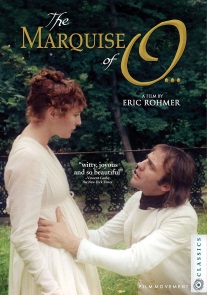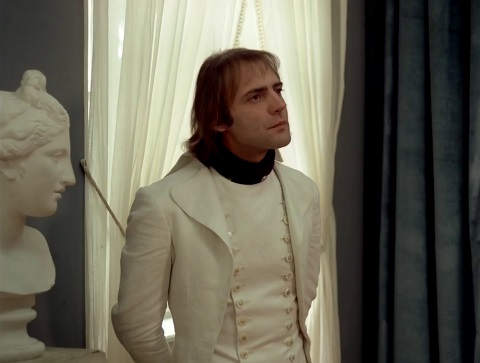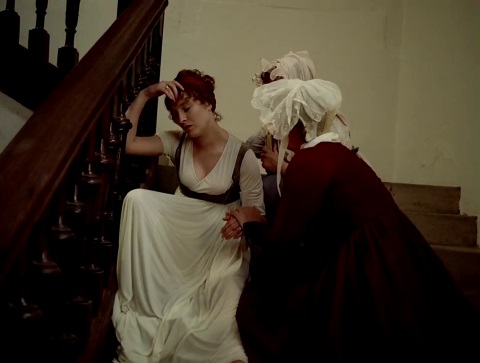

|
|
Marquise of O (The) AKA Die Marquise von O... AKA La Marquise d'O...
[Blu-ray]
Blu-ray A - America - Film Movement Review written by and copyright: Eric Cotenas (3rd November 2015). |
|
The Film
 BAFTA Film Award (Best Costume Design): Moidele Bickel (won) - BAFTA Awards 1977 Grand Prize of the Jury: Eric Rohmer (won) - Cannes Film Festival 1976 Palme d'Or: Eric Rohmer (nominated) - Cannes Film Festival 1976 Film Award in Gold (Best Performance by an Actress in a Leading Role): Edith Clever (won), Film Award in Gold (Best Performance by an Actor in a Leading Role): Bruno Ganz (won), Film Award in Gold (Best Production Design): Bernhard Frey, Hervé Grandsart, Helo Gutschwager, Rolf Keden and Roger von Moellendorff(won), and Film Award in Gold (Best Performance by an Actress in a Supporting Role): Edda Seippel (nominated) - German Film Awards 1976 Guild Film Award - Gold (German Film): Peter Handke (won) - Guild of German Art House Cinemas 1978 Chaplin Shoe (Best Actress): Edith Clever (won) - Munich Film Festival 1977 NBR Award (Best Foreign Language Film): The Marquise of O… (won) - National Board of Review, USA 1976 NSFC Award (Best Cinematography): Néstor Almendros (2nd Place) and NSFC Award (Best Director): Eric Rohmer (3rd Place) - National Society of Film Critics Awards, USA 1977 "The undersigned declares that, without her knowing how, she became pregnant. The father of the child she is bearing is asked to report himself. We have, for family reasons, decided to marry him." So reads the letter posted in an Italian gazette by Julietta the Marquise of O… (Edith Clever ), a young widow of heretofore unblemished reputation with two well-bred daughters. Months before, the citadel commanded by her father the Colonel (Peter Lühr) was stormed by the Russian army and Julietta was saved from a fate worse than death at the hands of soldiers by their lieutenant colonel The Count (Bruno Ganz, Nosferatu the Vampyre). Although her father vowed to "retort with shot and shell" and carry on as if his family were not there, he surrenders peacefully to The Count upon learning of his heroics in defending Julietta's honor. The Colonel is sent off prepare to leave the conquered citadel, having been given his freedom and permission to take his family wherever he wishes, while the upset Julietta is left there to rest under the influence of a sleeping draught. When she wakes, Julietta wishes to thank her savior only to learn from his father that The Count has already left. Some time later, the family is notified that The Count was killed in battle; it is thus a shock when he turns up at their home in town and proposes marriage to Julietta. Although The Colonel and his wife (Edda Seippel) feel that The Count's surprising romantic fervor – the image of her as a swan he remembers from his childhood on his parents' estate – seems rather abrupt, they agree that the marriage seems like a good match. Julietta, however, had vowed never to remarry but is urged to think it over by her parents. The Count, on the other hand, is impatient for an answer since he has a pressing assignment in Naples; but he is willing to give it up in order to await her answer. The family takes in The Count as their guest even as the parents argue that he would not be such a suitable mate if he were to throw away his military career, and Julietta feels guilty because she cannot give him an answer. They come to the agreement that The Count should go to Naples and that Julietta will not entertain any other proposals in his absence. Julietta starts to become more worried about her own poor health when she confides to her mother that symptoms she is feeling are like those when she was pregnant with her second child. Her mother jests "Perhaps you'll give birth|to a fantasy! The father will be Morpheus or one of his pageant of dreams…" (fitting as the film had earlier partially recreated onscreen Henry Fuseli's 1781 painting "The Nightmare"). As months pass and the signs are undeniable, Julietta sends for a doctor ( Eduard Linkers, Mr. Arkadin) and deems his diagnosis of her as a malicious insult even though she concedes that he has no motive to want to offend or humiliate her. When a midwife (Ruth Drexel) confirms that she is pregnant, Julietta desperately asks whether it possible to conceive without knowing it (the midwife replies that she knows of no other case than that of the Virgin Mary). While her mother says she could forgive a misstep, she takes offense a lie to avoid her anger, but Julietta insists that her conscience is clear. Her mother nevertheless disowns her and her father communicates in a dictated letter that he wishes her to leave and hopes to be spared the misery of ever seeing her again. Julietta is in danger of cracking under the emotional strain until her father attempts to claim her children and she stands up to him. Returning to the estate she inherited from her late husband, Julietta gives up trying to persuade her parents of her innocence and bows "to the holy and inscrutable laws of the universe", accepting her fate and resolving to put all her energy into the upbringing of her children. She cannot, however, bear the idea of a stigma on her third child, and resolves to find his father even though she cannot imagine marrying someone who "could only have sprung from the blackest and filthiest mire where he belongs." The Count returns from Naples and, upon learning of Julietta's situation from her brother ( Otto Sander , Wings of Desire), shocks everyone including Julietta by renewing his proposal with "absolute confidence in her innocence." Although The Colonel and his wife are justified in suspecting The Count himself of being the father of Julietta's unborn child, she insists that he must be the only one who is above suspicion: "One cannot rescue a woman and take advantage of her at the same time."   The Marquise of O is a departure from the modern settings of Rohmer's "Moral Tales", presenting the thought processes and moral sense of its female protagonist with the same degree of complexity usually afford to the aforementioned series' males who here are just as rigid even if we are not privy to their inner workings. The mother who says aloud she would "rather believe in some mysterious action of fate than in the infamy of a daughter" is afforded more depth and agency than Julietta who is just as concerned that the father of her child is not a scoundrel as her father is that he comes from a suitable background (or at least one that can be suitably elevated with some financial support); but how can a rapist not be the "scum of the earth" even if he attempts to make amends in restoring his victim's honor? Julietta, however, tells the perpetrator "I would never have thought you were a devil if when I first saw you, you had not seemed like an angel!" The film possesses a light comic warmth that anticipates Rohmer's later "Comedies and Proverbs" series of films with an optimistic spin on the ultimate moral choices of its characters. The film was photographed by the great Néstor Almendros (Days of Heaven) who recalls in his book "Man with a Camera" that the film's visual austerity was a collaboration with himself, Rohmer, the set and costume departments, and the long-dead architect of the two-hundred year old location. Shooting in a villa designed to take advantage of daylight in every room, Rohmer depended almost completely on natural light, utilizing mirrors to bounce fill lighting and balance contrast (an approach not that far removed from that of La Collectionneuse, Almendros' first work in color and third collaboration with Rohmer). The night scenes were shot with new high-speed film and the same fast lenses that John Alcott was utilizing at the same time on Barry Lyndon (save the Zeiss f/0.7 lens designed for NASA) with candlelight and some minor fill. Almendros had to convince costume designer Moidele Bickel that the pure white fabrics she chose for the wardrobe and set decoration would overexpose on film and the textures would not be retained unless they were dyed in English tea. The whites in the wardrobe (from Julietta's dresses to the Count's coat and trousers) do indeed look white onscreen against marble statues, greenery, and villa walls which painted gray to bring out other hues in the faces of the actors. The photography is as reliant upon symmetrical, painterly compositions (including one inspired by Henry Fuseli's "The Nightmare") over camera movement as the actors' performances are on mannered stillness and moving within the confines of the frame.  
Video
Released theatrically stateside by New Line Cinema during its more daring pre-A Nightmare on Elm Street days when they traded in a mix of art films (John Waters' Pink Flamingos, Borowcyzk's Immoral Tales, Visconti's Conversation Piece) and exploitation (Slave of the Cannibal God,The Streetfighter,The Evil Dead), The Marquise of O arrived on DVD stateside from Fox Lorber in a PAL-converted transfer (with the European DVD releases only marginally better). Rohmer's entire oeuvre was remastered in high definition in France last year, and The Marquise of O has thus far only been available as part of the twenty-two film, fifty-two disc Blu-ray/DVD combo Coffret Eric Rohmer boxed set. Film Movement's dual-layer 1080p24 MPEG-4 AVC transfer is framed in the original 1.33:1 aspect ratio with pillar-boxing, and it is brighter than the older transfers while retaining the warm look of Almendros' mostly natural-light photography.  
Audio
The German mono soundtrack is presented in an uncompressed LPCM 2.0 track with clean dialogue and on-set sound (the only instances of music are militaristic drums during the opening and closing credits). The optional English subtitles in a number instances tend to linger long past the German utterances until the next line of dialogue in the opening and a couple other instances but are always in sync with the dialogue (this was also an issue with the company's Blu-ray release of The Tall Blond Man with One Black Shoe).  
Extras
The extras are rather paltry. The archival interview with director Eric Rohmer (2:07) only briefly references the film, focused as it is on Rohmer's transition from literature to cinema to the stage with a production of an adaptation of "Katie of Heilbronn" (also by von Kleist) with his opinions on cinema versus the stage unformed at this early point during rehearsals. The archival interview with actor Bruno Ganz (2:54) focuses on how the film was his first feature film leading roll and the differences between acting for the stage and on film. As with the feature, some of the optional subtitles linger and overlap with the burnt-in subtitles during the film clip from the new master. The disc also includes a brand new 2015 trailer (1:34) for the film as well as the original 1976 trailer (4:17). Enclosed is a booklet in which critic David Thomson shuffles the chronology of a couple plot details in his essay but conveys his appreciation of the film while posing some stimulating questions.  
Overall
Eric Rohmer's mannered take on von Kleist's novel of "forced seduction" gets a respectable A/V presentation but the extras will disappoint. Although I do not know the extras content of the French edition, the supplements on the other French Rohmer blus seem more comprehensive (if not English-friendly).
|
|||||

|